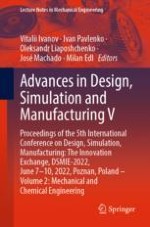This book reports on topics at the interface between mechanical and chemical engineering, emphasizing aspects related to design, simulation, and manufacturing. It covers recent findings concerning the mechanics of fluids, solids, and structures, and numerical and computational methods for solving coupled problems in manufacturing. Further, it reports on recent developments in chemical process technology, heat and mass transfer research, and energy-efficient technologies, describing applications in the food and energy production sector. Based on the 5th International Conference on Design, Simulation, Manufacturing: The Innovation Exchange (DSMIE-2022), held on June 7-10, 2022, in Poznan, Poland, this second volume of a 2-volume set provides academics and professionals with extensive information on trends and technologies, and challenges and practice-oriented experience in all the above-mentioned areas.
